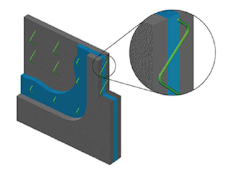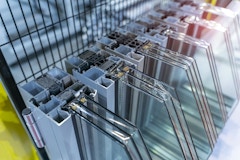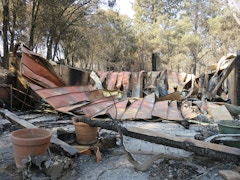
49 results
-
 With the desire for more sustainable construction and reduced embodied energy, mass timber is being explored for building structures. For medium and…
With the desire for more sustainable construction and reduced embodied energy, mass timber is being explored for building structures. For medium and… -

Skin Deep: Health, Wellness, and the Facade System
- Article by Christopher Payne, AIA, LEED AP, SKINS Content Editor
Here we are, a full year after the initial COVID-19 surge rocked the United States. It’s hard to believe we’ve been living through the pandemic for a full year at this point; and yet it also feels like it’s been multiple years. We are beginning to see glimmers of hope on the horizon as more people..
-

Facade Tectonics Forum: SEATTLE
- Event by Facade Tectonics Institute
FTI's celebrated Forum in Seattle explored the "facade effect" on buildings and urban habitat with industry and academic thought leaders.
-

Carbon Lean Facades
- Paper by Stefanie Schober · Jonce Walker, LEED AP, Certified Sustainable Building Advisor, and Fitwel Ambassador
With net zero and carbon neutral mandates on the near horizon, New York City has pushed the green building envelope by leveraging incentive-based
-

More Than a Facade
- Paper by Edward Losch · Marc Maguire
In 2014, the American National Standards Institute (ANSI) approved the Precast/Prestressed Concrete Institute (PCI) as an accredited ANSI Standards
-
Rammed Earth & Wildfire
- Paper by Brittany Dhawan, AIA
California is set to be drier and more drought prone with climate change. Wildfire and the subsequent loss of life and housing is a huge challenge.
-
Balustrade Design Loads
- Paper by Richard Green, SE, PE, P.Eng, CPEng, IntPE, APEC Engineer, M.ASCE M.IEAust, Founding Principal Andrew Crosby PEng, Principal Terrence McDonnell, Associate Principal
A review of balustrade practices from around the world, and why practices in United States and countries using ICC code/ASCE 7 designs are failing to… -

Silicone Spandrel Glass Opacifiers
- Paper by Scott Norville · Samir Blanchet · George Torok · Kris Vockler · John Swanson · Chris Barry · Lawrence Carbary · Stephane Hoffman · Timothy Krytenberg · Chris Fronsoe
Curtain wall design commonly uses insulating glass units for vision and spandrel glazing to provide better visual harmonization of building facade
-
A Structural Glass Design Manual
- Paper by Richard Green PE SE P.Eng CPEng IntPE(Aust) APEC Engineer, Principal / Owner Terrence McDonnell S.E., P.E., P.Eng., SECB, Principal Andrew Crosby BASc, P.Eng., LEED® AP BD+C, Principal
Other than limited special cases, there is a lack of standards providing guidance on the design of structural glass. This has resulted in an ad-hoc… -

The Evolution of AEC Professional Silos
- Paper by David Olsen, AIA, Senior Associate Megan Leon, P.E., Design Engineer Christopher Chiuchiolo, LEED AP, Project Manager Andrea Bono, P.E., LEED AP BD+C, Senior Consulting Engineer – Building Technology Nick Rustia, P.E., Facilities Development, Project Manager Diane T Sands, MLIS, MFA, MS-GIST, Librarian
Healthcare projects in northern California require specialized knowledge to navigate regulation, technological advancements, and project execution… -

Episode 03: DOE Does Windows
- Podcast by Stephen Selkowitz · Marc LaFrance
FTI's Mic Patterson sits down with special guests Steve Selkowitz of Lawrence Berkeley National Lab and Marc Lafrance of the Department of Energy .
-

From Design to Experiment
- Paper by E. Yagdir CELIKER, MSc., Research Assistant Oguz C. CELIK, PhD., Professor of Structural&Earthquake Engineering
Flat cable-net facades are form-active structures which provide maximum transparency by means of point fixing components, tensioned cables, and… -

U-Factor Matters in Hot Climates
- Paper by Helen Sanders, PhD
It is commonly thought that fenestration U-factor is not a key determinant in the performance of facades in hot climates, and generally the focus of
-
The Great Spandrel Glass Debate
- Paper by Richard Green SE PE P.Eng CPEng IntPE APEC Engineer M.ASCE M.IEAust, Principal / Owner
As we change the rules of thermal performance for facades, we are changing the conditions the glass is subject to in shadow boxes and glazed spandrel… -

Episode 01: Passive House
- Podcast by Lois Arena, PE
The Facade Tectonics Institute is pleased to launch our long-awaited podcast, starting with Episode 01: Passive House, a moderated discussion between Lois Arena, Director of Passive House Services at Steven Winter Associates and Spencer Culhane, Senior Building Envelope Specialist at Schüco USA.
-
Glass Balustrade Design
- Paper by Richard Green, PE, SE, P.Eng, CPEng IntPE(Aust), APEC Engineer, Principal/Owner Andrew Crosby, PEng, Principal Terrence McDonnell S.E., P.E., P.Eng., SECB, Associate Principal
Glass handrail design in the United States lags behind best practice in other parts of the world. There can be as much as a factor of four (4)… -

The Seismic Capability of Curtainwalls
- Paper by Peter Lalas MIEAust CPEng NER APEC Engineer IntPE(Aus)
The testing of aluminum/glass curtainwalls for seismic capability, mainly inter-story drift, has been carried out on many curtainwalls over the last
-
EVA Interlayers in Hardened Facades
- Paper by Nicholas Oberts, PE · Mark K. Weaver, PE, SE · Phillip Benshoof, PE
Explosions can result in very high loads of extremely short durations. Protective design to mitigate the effects of blast loading requires façade
-
Wind-Borne Debris Impacts on Façades
- Paper by Angela Mejorin, Ph.D., Researcher
Climate change effects are causing an increase in extreme wind events’ frequency and severity, worldwide. Regions that previously were not prone to
-

